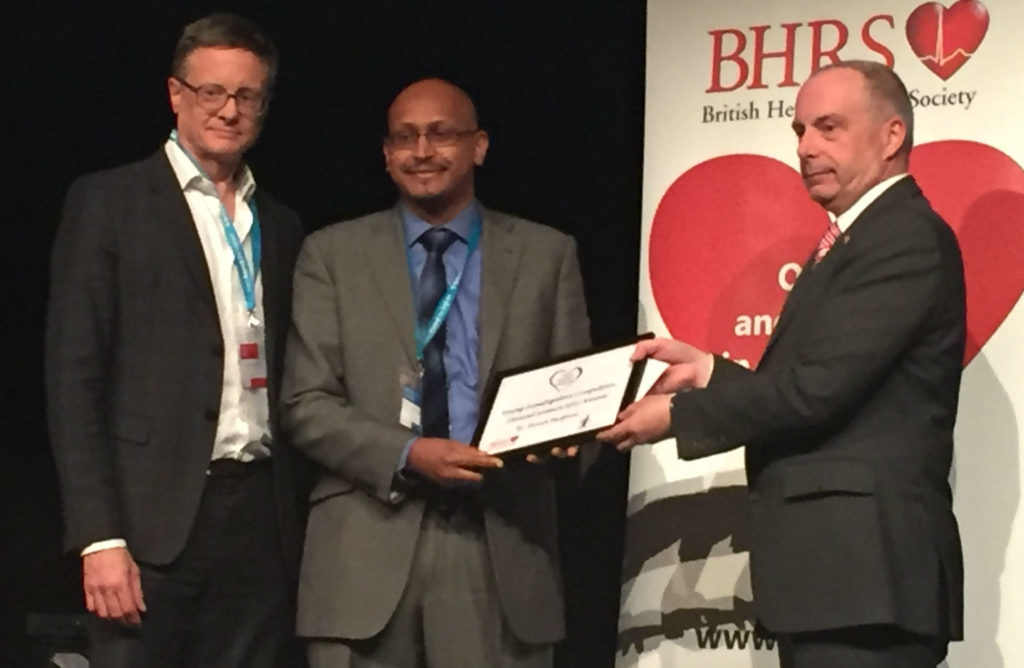
A first-of-its-kind study has found that male veteran athletes have a significantly higher prevalence of arrhythmias such as atrial fibrillation, atrial flutter, sinus pauses, and “alarmingly” non-sustained ventricular tachycardia when compared to sedentary controls, according to research presented at the Heart Rhythm Congress (HRC; 9‒12 October, Birmingham, UK).
The abstract, which won best research (clinical category) in the Young Investigators Competition at HRC, highlights that the substrate for arrhythmias is likely myocardial fibrosis caused by occult coronary atherosclerosis.
“In the future, this study may have implications of how we screen elderly athletes who engage in high intensity exercise,” lead investigator and presenter of the study, Ahmed Merghani (St George’s University of London, London, UK) told Cardiac Rhythm News. However, “large, long-term prospective studies are required to validate a tailored screening algorithm for asymptomatic veteran athletes,” he noted.
“Recent studies have raised alarm about the arrhythmia burden of veteran athletes but the prevalence of arrhythmias remains unclear as does the underlying substrate in these apparently healthy individuals,” Merghani told delegates.
The study which is funded by the British Heart Foundation and supervised by Sanjay Sharma (St George’s University of London, London, UK), investigated 152 veteran athletes (mean age 54.4±8.5 years; 70% males) and 92 controls of similar age. Veteran athletes were defined as more than 40 years of age, who ran ≥10 miles or cycled ≥30 miles per week and had competed in a minimum of 10 endurance events such as marathons and triathlons over a 10-year period. All participants underwent a 24-hour Holter, computational tomography (CT) coronary angiogram, and cardiovascular magnetic resonance imaging (MRI) with late gadolinium enhancement.
The researchers found that 44% of male athletes showed a higher prevalence of atherosclerotic plaques compared to 22% of male controls (p=0.009) and eight (7.5%) male athletes had a luminal stenosis ≥50% compared to none of the controls (p=0.05). Additionally, significant cardiovascular magnetic resonance with late gadolinium enhancement was observed in 17 male athletes (16%), one female athlete and none of the controls (p<0.0001). Eleven (10.4%) male athletes and one female athlete showed non-sustained ventricular tachycardia compared to none of the male or female controls (p=0.004). Of these 11 male athletes, three (27.2%) showed sub-endocardial late gadolinium enhancement on cardiac MRI and ≥50% luminal stenosis on CT angiography compared to eight (5.6%) with normal cardiac MRI and CT coronary angiography (p=0.03).
The authors noted that they did not find any relationship between atrial fibrillation/flutter, supraventricular tachycardia and pauses with myocardial fibrosis or coronary artery disease.
In conclusion, Merghani told Cardiac Rhythm News: “Chronic high endurance exercise in a proportion of male athletes who are over a certain age does promote atherosclerosis, scarring and arrhythmias.” Discussing future research, he said, they hope to follow-up these individuals to try to have a “clearer idea” if they have any strong cardiovascular endpoints. They will also look at the female veteran athletes in a larger cohort of patients.
Regarding the criteria for selecting this paper as the winner in the HRC Young Investigators Competition (clinical category), Pier Lambiase (UCL Institute of Cardiovascular Science and Barts Heart Centre in London, UK), judge in the competition said: “This is a really interesting and novel study and nothing has been previously published in this area. We were particularly interested because of its clinical importance for endurance athletes and because it was developed in a very systematic way.”
In the interview below, Merghani gives further insights on the results of this study.









